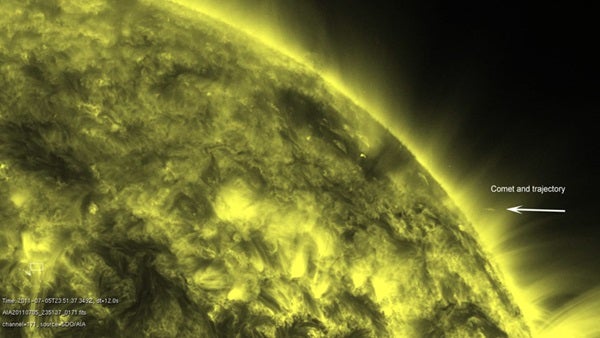Comets are giant dusty snowballs believed to date from the epoch of the formation of the Sun and planets, so they carry important information about the early history and composition of the solar system. The comets we see spend most of their time very far from the Sun, orbiting in the so-called Oort Cloud, before being disrupted into orbits that carry them toward our nearest star over tens of thousands of years.
When comets reach the inner solar system, their dusty ices melt and vaporize to form huge tails blown back by the solar wind and sunlight. The largest, like the famous Comet Hale-Bopp seen in the late 1990s, have nuclei tens of kilometers across and masses of 10 million million tons. Objects this large only lose a tiny fraction of their material on each passage around the Sun, so they are able to survive thousands of journeys through the solar system. In contrast, the smallest objects may only be 33 feet (10 meters) across with a mass of 1,000 tons. If these small comets make a close approach to the Sun, they are vaporized by sunlight and the friction of the atmospheric gas.
In the culmination of work carried out over the past few years, Brown and his colleagues are now able to predict how comets lose their mass and are destroyed in the solar atmosphere, their behavior depending on whether or not their orbital path reaches into the “lower atmosphere” 4,300 miles (7,000 kilometers, or roughly 1 percent of the solar radius) from the top of the brightest visible solar layer, the photosphere. The team worked out the different ways comets give up their mass, momentum, and energy to the Sun’s atmosphere according to their height. Above 4,300 miles, sunlight slowly vaporizes the cometary nuclei, and the gases streaming off into the coma and tail lose energy and momentum by atmospheric drag. In the low solar atmosphere, material is stripped away not by sunlight but by the drag of the solar gas surrounding the comet and by exploding under the “ram pressure” force of the atmosphere as the comet runs into denser layers.
The group found that “sunskimming” comets (those with their closest approach more than 4,300 miles from the Sun) are destroyed in a slow “fizzle” that lasts hundreds to thousands of seconds, depending on their mass. During their demise, they should emit weak but detectable extreme ultraviolet (XUV) radiation. In contrast, the “sunplungers” that approach the Sun more closely will be destroyed in a few seconds as they crash into the dense layers of the lower solar atmosphere. The resulting explosions produce effects similar to those of solar flares, such as sunquakes on the Sun’s surface. Finally, if the most massive comets were to collide with the Sun, they would produce dramatic explosions just above the photosphere itself.
In July and December last year, NASA’s Solar Dynamics Observatory (SDO) made the first direct observations of comets making close approaches to the Sun. The first comet, C/2011 N3 (SOHO), was completely destroyed after passing 62,000 miles (100,000km) above the photosphere while the second and larger comet, C/2011 W3 (Lovejoy), survived a close approach of a similar distance 87,000 miles (140,000km) — although it lost a significant fraction of its mass in the process. Both events were in line with the predictions of Brown and his collaborators. They emphasize that, contrary to some news releases, the death or attrition of such comets has nothing to do with the high temperature (3.6 million degrees Fahrenheit [2 million degrees Celsius]) of the outer solar atmosphere because, though hot, it is so tenuous that it contains little heat.
“In modeling how icy comets behave in this extreme environment, we really are starting to understand what happens to these ‘supersonic snowballs in hell’ when they make a close approach to the Sun,” Brown said. “The two sunskimmers seen last year have already given us a new insight into the Sun’s atmosphere, and it’s only a matter of time before we see the flare from a sunplunger — with a low enough orbit to reach the lower atmosphere of the Sun. When that happens, we will be able to analyze the light from the resulting ‘cometary flare’ and find out even more about the composition of the interiors of comets.”










